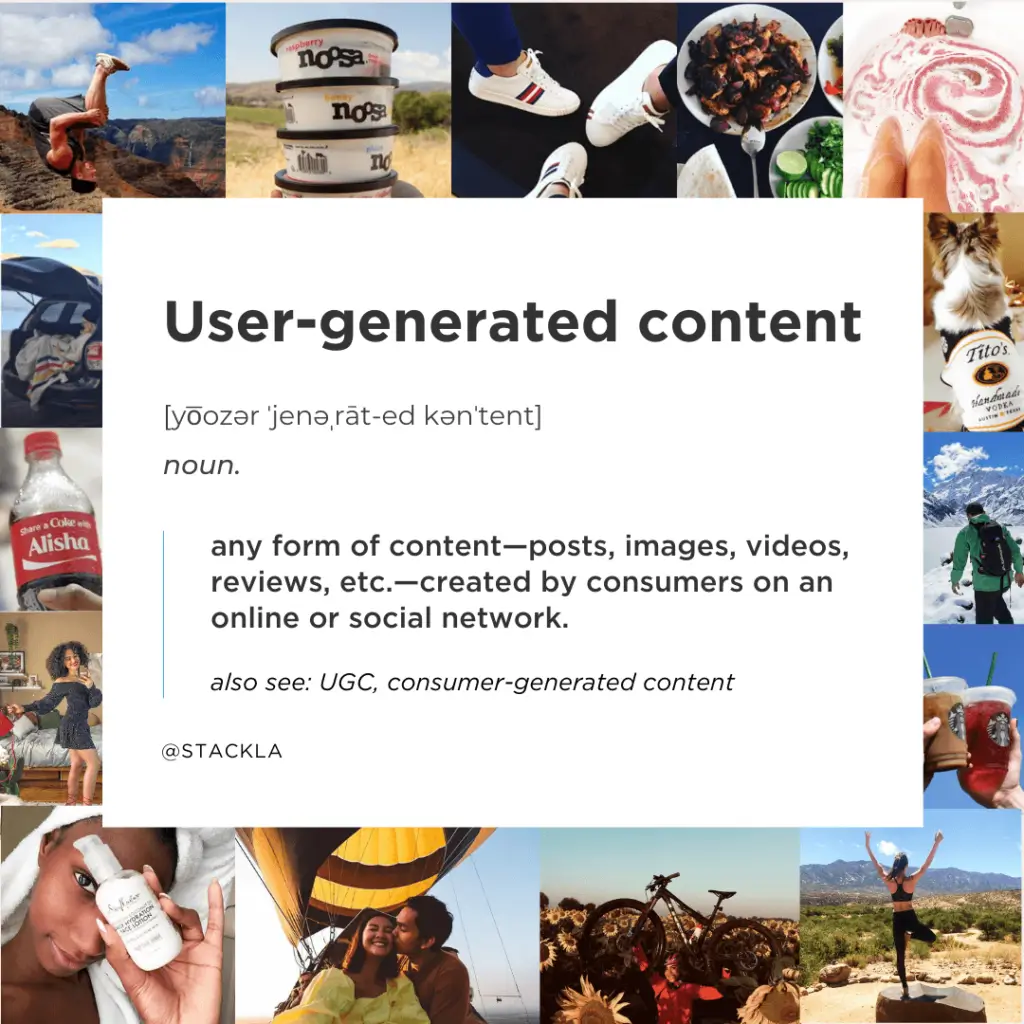Introduction to User-generated Content
User generated content (UGC) refers to any form of content that users create, consumers, or fans of a brand, product, or service. It is shared publicly or privately through various online platforms. In other words, UGC is any content created by the people for the people without the direct involvement of the brand or business.
UGC has increased recently as more people use social media and other online platforms to express their opinions, share their experiences, and connect with others. From reviews and ratings to social media posts, blogs, videos, and photos, UGC has become an essential part of our daily lives and a powerful tool for businesses to engage with customers and build brand awareness.
The Importance of UGC
UGC is influential for several reasons, including:
- Increased engagement: UGC encourages customers to interact with your brand and share their experiences, which can lead to increased engagement and loyalty.
- Authenticity and trustworthiness: UGC is seen as more authentic and trustworthy than traditional marketing messages, as it comes directly from the customers themselves.
- Cost-effective: UGC is often less expensive than traditional marketing efforts, relying on user-generated content rather than expensive advertising campaigns.
- Improved SEO: UGC can enhance your search engine rankings by providing fresh, relevant content that is updated regularly.
Examples of UGC
Some typical examples of user-generated content include:
- Social media posts: User-generated content can be found on social media platforms such as Facebook, Twitter, Instagram, and TikTok, where users share their thoughts, experiences, and opinions.
- Reviews and ratings: on platforms like Yelp, TripAdvisor, and Google My Business, provide valuable customer feedback and insights.
- Blogs and articles: UGC can also be found in blog posts, articles, and other written content created by users.
- Videos: User-generated content, such as product reviews and unboxing videos, is a popular form of UGC.
- Photos and images: User-generated images and photos, such as those shared on Instagram and Pinterest, can showcase products and services more naturally and relatable way.
- Forums and discussion boards: Online forums and discussion boards are another forms of UGC, where users can share their opinions and experiences on a particular topic.
Understanding the benefits, types, challenges, and best practices for managing user-generated content can help businesses incorporate UGC into their marketing strategies, build stronger customer relationships, and drive engagement and growth.
Benefits of User-Generated Content
User-generated content (UGC) is any content, whether text, images, videos, or audio, created by use rather than by the brand or business itself. It is a powerful tool for marketers to engage with customers and build brand awareness. In this article, we will explore the benefits of UGC.
Increased Engagement
UGC encourages customers to interact with your brand, share their experiences, and connect with others. This can lead to increased engagement and loyalty. According to a study by Olapic, UGC can increase conversion rates by up to 4.5 times, and shoppers who interact with UGC are 97% more likely to convert than those who do not.
Authenticity and Trustworthiness
User-generated content is seen as more authentic and trustworthy than traditional marketing messages, as it comes directly from the customers. This is particularly important today when consumers are increasingly skeptical of corporate messaging. According to a survey by Stackla, 86% of consumers say authenticity is important when deciding which brands they like and support.
Cost-Effective
UGC is often less expensive than traditional marketing efforts, relying on user-generated content rather than expensive advertising campaigns. By encouraging customers to share their experiences and opinions, businesses can generate a steady stream of content without needing a large marketing budget.
Improved SEO
UGC can improve your search engine rankings by providing fresh, relevant content that is updated regularly. Search engines love new content, and UGC can help your website rank higher in search results. According to a study by Moz, websites with UGC have a 4.5% higher conversion rate than those without.
Social Proof
UGC can serve as social proof, proving that others have had positive experiences with your brand. This can be particularly powerful in persuading potential customers to make a purchase. According to a study by BrightLocal, 88% of consumers trust online reviews as much as personal recommendations.
User-generated content is an integral part of any marketing strategy. By leveraging the power of UGC, businesses can increase engagement, build trust, and improve their search engine rankings, all while keeping costs low. To effectively incorporate UGC into your marketing strategy, it is essential to set clear guidelines, moderate content appropriately, encourage positive contributions, and respond promptly to feedback and concerns.
Challenges and Risks of User-Generated Content
User-generated content (UGC) benefits businesses, as discussed in previous articles. However, there are also challenges and risks associated with UGC that companies must be aware of. This article will explore some of the challenges and risks of user-generated content.
Quality Control
One of the main challenges of UGC is quality control. When customers create content, there is no guarantee that the content will meet your brand’s standards or be appropriate for your target audience. This can lead to low-quality content that does not reflect well on your brand.
Legal Issues
User-generated content can also present legal issues for businesses. For example, you could be liable for customers posting or violating copyrighted material. It is essential to have clear guidelines for what types of user-generated content are acceptable and to monitor UGC regularly to ensure it meets legal standards.
Negative Content
Another risk of UGC is the possibility of harmful content. While UGC can be a powerful tool for building brand loyalty, it can also be used to spread negative messages or criticisms about your brand. This can be particularly damaging if harmful content goes viral or is shared widely on social media.
Trolls and Harassment
UGC can also attract trolls and harassers, who may use your brand’s platform to spread hate or negativity. It is essential to have clear guidelines for dealing with trolls and harassment and to monitor UGC regularly to ensure that it does not become a platform for hate speech or abuse.
Brand Reputation
Finally, UGC can impact your brand’s reputation. If customers post inappropriate or low-quality content, it can reflect poorly on your brand and damage your reputation. A strategyrating UGC and ensuring that only high-quality, appropriate content is posted on your brand’s platform is essential.
While UGC can be a powerful tool for esses, it also comes with challenges and risks. It is essential to have clear guidelines for moderating UGC and ensuring that it meets your brand’s standards. Businesses can harness their power by carefully managing UGC while minimizing their risks.
Best Practices for Managing User-Generated Content
User-generated content (UGC) can be a powerful tool for businesses to engage with customers and build brand awareness. However, managing UGC can be challenging, as discussed in previous articles. In this article, we will explore best practices for managing user-generated content.
Set Clear Guidelines
Setting clear guidelines for what types of user-generated content are acceptable on your brand’s platform is essential. This can include policies for content quality, appropriate language and behavior, and legal compliance. By setting clear guidelines, you can ensure that UGC meets your brand’s standards and does not violate legal requirements.
Moderate Regularly
Regular moderation is vital to managing UGC effectively. This includes monitoring content for inappropriate or low-quality posts, responding to customer feedback and concerns, and removing content that violates your guidelines. By moderating UGC regularly, you can ensure that your brand’s platform remains a positive and engaging space for customers.
Encourage Positive Contributions
One of the benefits of UGC is that it can encourage customers to share their experiences and connect with others. To promote positive contributions, consider running UGC campaigns or contests, featuring customer stories on your website or social media channels, and responding to positive contributions with recognition and appreciation.
Respond to Feedback and Concerns
It is essential to respond promptly to customer feedback and concerns about UGC. This can include addressing negative comments or criticisms, thanking customers for positive contributions, and supporting customers with negative experiences—customer trust and loyalty to your cars by responding promptly and appropriately.
Monitor for Trolls and Harassment
Unfortunately, UGC can attract trolls and harassers who may use your brand’s platform to spread hate or negativity. It is essential to monitor UGC regularly for these posts and have a clear strategy for dealing with trolls and harassment. This may include removing offending posts, blocking users who engage in harassment, and reporting any illegal activity to the appropriate authorities.
Measure Results
Finally, it is essential to measure the results of your UGC efforts. This can include tracking engagement metrics such as likes, shares, and comments, monitoring conversion rates for UGC-related campaigns, and conducting surveys to gather customer feedback. By measuring the impact of UGC on your brand, you can make informed decisions about optimizing your UGC strategy.
Managing UGC effectively requires explicit guidelines, regular moderation, positive encouragement, prompt response to feedback and concerns, monitoring for trolls and harassment, and measuring results. By following these best practices, businesses can harness the power of UGC to engage with customers and build brand loyalty.
Strategies for Incorporating User-Generated Content into Your Marketing Strategy
User-generated content (UGC) can be valuable to your marketing strategy. It can help build customer trust, increase engagement, and generate new leads. However, incorporating UGC into your marketing strategy requires careful planning and execution. This article will explore strategies for incorporating UGC into your marketing strategy.
Define Your Objectives
The first step in incorporating UGC into your marketing strategy is to define your objectives. What do you want to achieve with UGC? Is it to increase brand awareness, drive sales, or improve customer engagement? By specifying your dreams, you can develop a UGC strategy aligning with your marketing goals.
Identify Your Audience
Next, it is essential to identify your target audience. Who are you trying to reach with your UGC strategy? What types of content do they create and engage with? By understanding your audience, you can develop UGC campaigns that resonate with them and increase their engagement with your brand.
Choose the Right Platform
You can use many platforms to incorporate UGC into your marketing strategy. Social media platforms like Instagram, Twitter, and Facebook are popular choices. However, you may consider creating a dedicated UGC platform on your website or partnering with existing UGC communities. Choose a platform that aligns with your brand’s goals and target audience.
Encourage User Participation
It would help if you encouraged user participation to incorporate UGC into your marketing strategy. This can include creating UGC campaigns or challenges, featuring user-generated content on your website or social media channels, and offering incentives for users who create and share UGC. You can generate more UGC and increase engagement with your brand by encouraging user participation.
Curate and Moderate UGC
Once you have generated UGC, it is essential to curate and moderate it. Curating UGC involves selecting the best content to feature on your website or social media channels. Moderating UGC involves monitoring content for inappropriate or low-quality posts, responding to customer feedback and concerns, and removing content that violates your guidelines. By curating and moderating UGC, you can ensure that your brand’s platform remains a positive and engaging space for customers.
Analyze Results
Finally, it is essential to analyze the results of your UGC strategy. This can include tracking engagement metrics such as likes, shares, and comments, monitoring conversion rates for UGC-related campaigns, and conducting surveys to gather customer feedback. By analyzing the impact of UGC on your brand, you can make informed decisions about optimizing your UGC strategy.
Incorporating UGC into your marketing strategy requires careful planning and execution. By defining your objectives, identifying your audience, choosing the right platform, encouraging user participation, curating and moderating UGC, and analyzing results, you can harness the power of UGC to engage with customers and build brand loyalty.
Conclusion: The Future of User-Generated Content
User-generated content (UGC) has become an increasingly important part of the digital landscape, providing valuable opportunities for brands to engage with customers, build brand loyalty, and increase sales. As we look to the future of UGC, it is clear that it will continue to play a significant role in digital marketing strategies.
UGC will continue to drive engagement
As social media platforms and other online communities continue to grow, the opportunities for UGC will also increase. By encouraging users to create and share content related to your brand, you can increase engagement and develop a sense of community around your brand.
UGC will become more diverse
As UGC continues to evolve, we will likely see a greater diversity of content. This may include more video content, augmented reality experiences, and other interactive forms of UGC. By embracing these new forms of content, brands can create more engaging and immersive customer experiences.
UGC will be more closely integrated with other marketing channels
As UGC becomes more critical, it needs o integrate more closely with other marketing channels. This may include using UGC in email marketing campaigns, incorporating UGC into paid advertising, and using UGC to inform product development.
Brands will need to be more strategic with UGC.
As UGC becomes more prevalent, it will become increasingly crucial for brands to use it strategically. This may involve developing more targeted UGC campaigns, investing in UGC moderation and curation tools, and developing metrics to measure the impact of UGC on their overall marketing strategy.
UGC will continue to be a valuable source of customer insights
Finally, UGC will continue to be a valuable source of customer insights. By monitoring UGC, brands can gain a deeper understanding of their customer’s needs and preferences and use this information to inform their overall marketing strategy.
UGC is a powerful tool for brands looking to engage with customers and build brand loyalty. As we look to the future, we can expect UGC to become even more critical, diverse, and integrated with other marketing channels. By embracing UGC and strategically using it, brands can create more meaningful and engaging customer experiences.
F.A.Q
How to create user-generated content?
Creating user-generated content (UGC) is a great way to engage with your audience, build brand loyalty, and increase sales. Here are some tips on how to create UGC:
- Set clear goals and guidelines: Before creating UGC, it’s essential to have clear goals and procedures. This will help ensure that the content you receive is aligned with your brand and marketing objectives.
- Choose the right platform: There are many platforms you can use to solicit UGC, including social media, blogs, and forums. Choose the platform that best aligns with your audience and brand.
- Make it easy for users to participate: Make sure the process for creating and submitting UGC is as easy and intuitive as possible. Provide clear instructions and tools to make it simple for users to participate.
- Offer incentives: Consider offering incentives for users who create and submit UGC. This could be anything from a discount code to a chance to win a prize.
- Showcase UGC: Once you start receiving UGC, showcase it prominently on your website, social media channels, and other marketing materials. This will encourage more users to participate and help build a community around your brand.
By following these tips, you can create UGC that engages your audience and helps you achieve your marketing goals.
Do you have to pay for user-generated content?
In most cases, you do not have to pay for user-generated content (UGC). UGC is typically created and shared by users voluntarily and without compensation. However, it’s important to note that this rule has some exceptions.
For example, suppose you plan to use UGC in your advertising or other commercial materials. In that case, you may need to obtain permission from the user and potentially compensate them for using their content. This is especially true if you plan to use the content in a way that implies endorsement or sponsorship by the user.
Additionally, some UGC platforms, such as Instagram and YouTube, have their policies regarding the use of UGC. These policies may require you to obtain permission from the user before using their content or limit how you can use it.
Generally, it’s always a good idea to be transparent and respectful when using UGC. This means giving credit to the user whenever possible and being clear about how their content will be used. Doing so can build trust with your audience and avoid any potential legal issues.
What is user-generated content on social media?
User-generated content (UGC) on social media refers to any content created and shared by users on social media platforms, such as Facebook, Instagram, Twitter, TikTok, and YouTube. UGC can take many forms, including photos, videos, reviews, comments, etc.
One of the defining characteristics of UGC on social media is that it is created and shared by users rather than by brands or other organizations. UGC can be a powerful tool for building brand awareness and engagement, as it allows brands to tap into the creativity and enthusiasm of their audience.
Some common examples of user-generated content on social media include:
- Customer reviews and testimonials
- Photos and videos of customers using or enjoying a product
- User-generated hashtags and challenges
- Fan art and other creative expressions of fandom
- Comments and feedback on social media posts
Brands can encourage UGC on social media by creating contests, offering incentives, or simply asking followers to share their content using a specific hashtag or other call-to-action. By incorporating UGC into their social media strategy, brands can build stronger relationships with their audience and create more authentic, engaging content.







